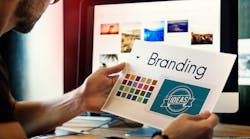Latest from Best Practices
Sponsored
By Valerie Jimenez
Anyone skimming the help-wanted ads will find thousands of openings for workers with plumbing skills. But while the jobs are there for the taking, people with the credentials to fill them are not. According to data generated by the US Bureau of Labor Statistics, there were 412,000 construction-sector job openings in February, which includes thousands of calls for plumbers. And while there are many, many more jobs than there are tradesmen, the pipeline for new talent is running perilously low.
The impact of the nationwide staffing shortage in the trades resonates most strongly among smaller businesses like those of the typical plumbing shops, who often don’t have the splashy profiles that give them first pick of graduating students.
But there is a solution: I specialize in helping forward-thinking small businesses use branding to make their company appeal to millennials and to that oh-so-coveted unicorn, the recent trade-school grad. Over the last decade, I have met with almost one hundred mid-size commercial GCs and contractors, including dozens of plumbing shops. Their concerns are always the same; they lose the best talent to bigger companies that have benefits that most of them cannot match. But when I talk to younger people—say, 45 and under—in the trades, most are adamant that they would much rather work for a smaller, friendlier company because it feels less corporate, and the relationships they establish are much more sincere.
Let’s take a look at a few companies that used branding to help solve their staffing issues:
According to Carmen Autry, CEO of NTD Mechanical, “We’ve always been fortunate to have work in the pipeline, so when our biggest challenge—finding talented plumbers, HVAC techs and other professionals—became chronic, we knew we had to think out of the box and create a “brand” identity for NTD.” She knew that NTD offered a “fun-loving” culture that couldn’t be matched by larger competitors, so she doubled-down and made it the focus of her website. “It worked,” Autrey asserts. “Now that we have a visible—and very compelling—online presence, recent grads want to meet us.”
All Tech Electric, which is currently led by second-generation owner Kelly Smith, found that using “consumer” marketing techniques was a game-changer. “It was hard to admit, but our public image was dull, with zero ‘cool factor,’” Smith laughs. “By using energetic visuals, spoken-like-a-regular-guy content, and music that appeals to a younger audience—who always expect to be associated with a persona or an image—we’re seeing a measurable improvement in our ability to add truly outstanding tradespeople to our workforce.” Smith asserts that branding is not an overnight fix. “You have to give it time,” she explains, “but since the launch of our new website and updated branding, we receive constant messages from potential candidates, something we never saw before.”
It was easy for me to spot why Phillips May was having problems attracting talent through their dreary, utterly nondescript website. But when I visited the shop floor, I found a truly extraordinary workplace, with deep friendships between the coworkers and a palpable sense of camaraderie. I knew that many tradespeople would love to call a place like that home, but nobody knew about it!! So we brought our professional video and photo crew in and spent the next few days capturing the company culture by shooting interviews with everyone from the C-suite to their HR manager. Importantly, their website features all staff members—not just senior management—so potential employees of all skill levels can visualize themselves working there.
Here are four tips for when you embark on your own branding adventure.
Tip #1: DIY is for crafts, not branding.
Like the plumbers that shake their heads when they see a layman attempt to pipe a bathroom, I smile when someone tells me they’ve put their branding in the hands of an “artsy” friend or an already overworked staffer. When you tally all the costs, it’s usually cheaper—and always more effective—to let an expert build from the ground up than it is to try to renovate what you already have.
It may feel counterintuitive to open your wallet for something that isn’t a “hard” investment like upgraded tools, but by hiring experts, you’re almost guaranteed to save money in the long run because you won’t be fixing amateur hour mistakes. A seasoned pro helps you make strategic decisions, like what type of content to include on your site, and they also think about future needs, for example, how to build a website that’s easy to update so you can add things like new-hire profiles, job-in-progress photos, shout-outs to employees who earned new licenses, or links to interesting stories.
Tip #2: Think about the brands and products that resonate with your employees.
What do your employees tend to like? Hard rock and Harleys? Family picnics and group fishing trips? Your marketing firm should spend time with your people and take their branding cues from them. Another important, related point: If a good portion of your workforce is more comfortable speaking/reading in a language other than English, offer a 2nd language tab on your website, and push out your social media in both languages. Hiring experts that are well-versed in multicultural marketing is always a good idea. This ensures that whatever you are publishing is culturally-appropriate and respectful.
Tip #3: Who are you? Say it loud and say it often!
Once you’ve determined who you are, don’t be shy about telling the world! Creating your website is step #1. To get more mileage out of your investment, extend your communications to platforms like Facebook, LinkedIn, Twitter, Instagram, and even TikTok!
Always pay special attention to your “careers” content, which should highlight the career trajectories of several employees, list of your open positions, and provide an easy way for candidates to apply or send their resume for future consideration. Remember to also showcase the types of projects you have done/are doing to show that people can grow professionally with you—this is especially important to younger workers—and that you have the kind of workflow that results in job security, which resonates more strongly among seasoned workers. Your “Missions Accomplished” tab should be updated every 3-6 months and include lots of photos of jobs well done.
Tip #4: Keep up a steady stream of fresh, professional content.
Ok, so you’ve created your brand. Bravo! Now you need to “feed” it to keep it fresh and current. Remember that visuals and text should be consistent, eye-catching and friendly. Keeping your public face fresh and vital will show potential employees that you’re proud of who you are. This is the type of intangible factor that can be a huge benefit in the recruiting process.
And, just like with brand development, content creation is a job best left to trained professionals. An agency that specializes in B2B knows how to do things like content, graphics, and SEO optimization better (and in the end, less expensively) than a layman.
If construction/contractor firms want to Increase their flow of candidates—as measured by both pure numbers and by quality—then traditional branding initiatives can be quite effective. That’s because a carefully constructed external image makes it much easier for companies to find employees (and perhaps more importantly, to find the right employees) in a crowded, competitive field.
Valerie Jimenez is the Founder and CEO of Bold Entity, (https://boldentity.com) a Dallas-based, full- service branding and digital marketing agency committed to helping small to midsize companies—especially those in the chronically underserved business-to-business (B2B) sector—expand their business and increase revenue.


